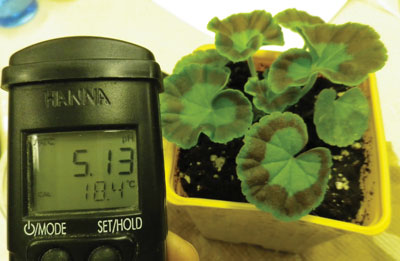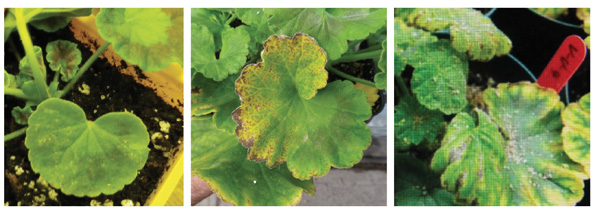
Features
Crop Culture
Inputs
Growing Points: Understanding pH and EC
March 20, 2013 By Dr. Mohyuddin Mirza
The subject of pH and EC has been discussed frequently. I would like you
to check the March 2012 issue of Greenhouse Canada for some details on
this subject.
The subject of pH and EC has been discussed frequently. I would like you to check the March 2012 issue of Greenhouse Canada for some details on this subject.
Every year I see problems in spring with greenhouse crops, both ornamental and vegetable. Understanding pH sometimes becomes an issue itself because it is what I call “logarithmic” in nature.
Growers who are busy growing plants have no time to regularly monitor the pH of the crops by leaching or draining water through a pot and taking measurements, and then following the trend by making a graph. It also involves regularly calibrating the pH and EC meter and reading the warning signs of upcoming pH and EC issues. I would like you to look at the picture below:

|
This grower bought a new pH meter and wanted me to show her how to use it properly. These meters have become more user-friendly but the “fear factor” of using them is still there. I think that fear has to be removed! If we use the meters properly and interpret the results properly, we can access very useful information to grow good quality plants.
When I looked at this plant, it looked fairly good and green. The roots were in good shape. The pH by leach method alerted me that problems were developing. I looked closely on the lower leaves and found tiny specks as you can see on the picture on the left (next series of photos).

|
These tiny specks on lower leaves of this geranium, combined with the information from the pH meter, was enough to make a decision that iron toxicity is developing and could develop into a plant like the one in the middle.
The picture on the right is an extreme example as to what can happen if the pH is not corrected; it is sometimes misdiagnosed as bacterial leaf spot and growers will start applying chemicals to control the perceived bacterial disease. In iron-efficient plants, such as geraniums, when acidic pH is below 5.5, iron uptake is increased. As the pH goes lower, the symptoms get worse.
Magnesium deficiency is also indicated in the picture on the right.
The pH story in vegetables is somewhat similar. Look at the pictures below.
 |
The photo on the left is what the grower observed. The pH and EC levels did not give any clue to why these leaves died – the values appeared to be in correct range.
However, when I asked the grower to check the pH and EC in the coir bags, top and bottom, the results were revealing. At the top, the pH was 4.7 and the EC was 5.7 mmhos/cm. At the bottom, the pH was still 4.7 and EC was 2.7 mmhos/cm.
It was interesting to see that the feed and drain appeared to be in line with the recommended ranges, but the coir bags showed high values. The salts were brought to the top likely due to the evaporation of water and the capillary action.
With drip irrigation, the leaching is relatively restricted as compared to watering by hand from the top. In the case of cucumbers, a pH below 5.2 is cause for concern. The toxicity of trace elements takes effect and the lower leaves will be affected first. Roots will be damaged, top growth slows down and fruit abortion can occur.
In this case, the grower was advised to apply potassium bicarbonate and do some leaching. After leaching, the pH went up to 6.1 and EC dropped to about 2.8. The plant response can be seen in the picture on the right.
- EC is measured in millimhos or milliSiemens/cm. Simply stated, it is the amount of electrical current conducted through a solution. Horticulture has adopted this measurement and it is widely used in managing crops. I want to just highlight some points for growers:
- EC is not a substitute for a nutrient analysis.
- Most fertilizers used in greenhouses, except urea, contribute to the EC content of the growing medium. The most common are ammonium, nitrate, phosphate, potassium, calcium, magnesium, sulphates, chlorides and bicarbonates.
- Sulphates and chlorides leach easily from the growing medium but if leaching due to irrigation is not adequate, the EC can increase and can affect plant growth.
- Management of EC depends on light. The higher the light, the lower the EC should be. In winter, higher EC values are used to control the uptake of water due to osmotic pressure restriction in the root zone.
- Higher EC values are used for tomatoes, compared to those used for cucumbers and peppers.
- Note that pH and EC sensors should be calibrated frequently because very critical decisions are made based on the information they provide. Growers should be aware which fertilizers contribute the most towards EC. Good EC and “ppm” nitrogen tables are available.
Intelligent use of this information can lead to good quality crops and fruits and foliage.
Dr. Mohyuddin Mirza is a greenhouse consultant. • drmirzaconsultants@gmail.com
Print this page